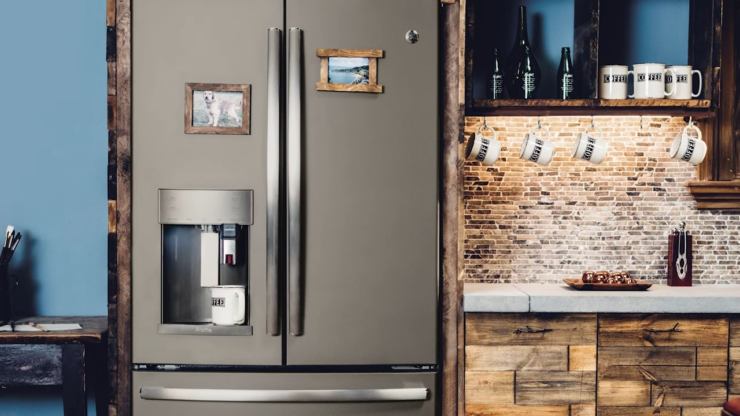When shopping for a new refrigerator, understanding the power requirements of a different model is important in order to ensure you select the right size appliance for your home. In terms of electricity usage, it’s helpful to understand how many amps your refrigerator model uses as this will allow you to calculate your monthly energy costs.
This guide will provide information on the basics of electrical current, how it affects refrigerators, and what kind of amp ratings you should expect from different models.
Basic Electrical Terms: When dealing with electricity and appliances, there are some terms you should be familiar with such as watts, volts, and amps. Watts refer to the amount of power (or energy) needed for an appliance to function and volts refer to the voltage supplied to power the appliance.
Amps (or amperage) are a measure of electrical current and denote how much current flows through an electrical circuit or appliance per second. When looking at a label or technical data sheet for most appliances, refrigerators, watts, and volts can be used in conjunction with amps in order to determine how much power is consumed by that appliance over time.
Factors that Affect Refrigerator Amperage
Refrigerators use varying amounts of amperage depending on a few factors. The size and age of the refrigerator are two of the primary factors that determine how much amperage it will use. Other factors can also contribute to the amperage that a refrigerator needs to run such as the type of compressor, insulation, and the refrigerator’s temperature setting.
Let’s explore these factors in more depth.
Size of the Refrigerator
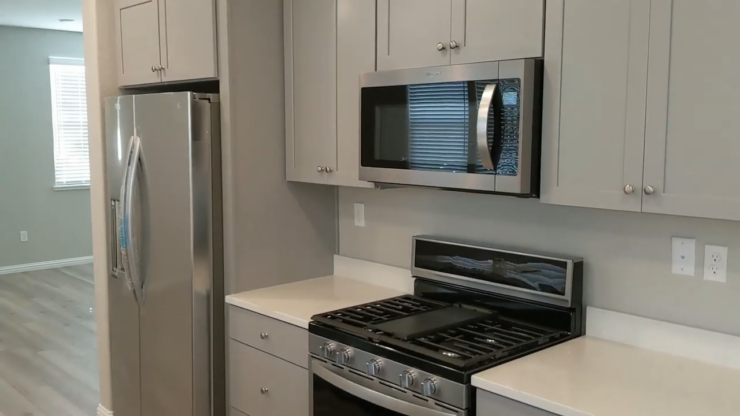
The size of the refrigerator is a major factor when determining how many amps it will use. A larger appliance, such as a side-by-side or French door model, will usually require more amperage than a smaller unit, such as a top-freezer model. Additionally, the amount of food stored in the refrigerator can also have an impact on the total amperage required. As more food is added to the interior, more energy is needed to keep the contents cold.
Another factor that affects refrigerator amperage is its age and condition. Over time, components within a refrigerator can become less efficient and require more electricity to power them properly. Additionally, features like cooling systems and ice makers will also increase an appliance’s overall power consumption. Consulting with a qualified technician can help determine what additional requirements your particular refrigerator may have in order to run efficiently and safely.
Age of the Refrigerator
Age is an important factor that affects a refrigerator’s amperage. Older refrigerators, those more than 10 years old, are usually more inefficient and are typically rated for higher amperage. This is due to the use of less efficient cooling technologies, such as traditional compressor motors running at relatively high speeds. The average refrigerator manufactured today, however, is much more efficient and can be rated for sizes closer to or even below 15 amps.
Furthermore, as technology advances, there have been increases in fridge efficiency which translates into even lower amp ratings over time. Newer and more expensive high-end models can often run on significantly lower amp ratings due to the use of advanced features such as variable speed compressor technology or multiple condenser fan motors running on alternating cycles. Therefore it is important to take into consideration the age of a refrigerator when evaluating its amperage requirements.
Type of Refrigerator
The type of refrigerator you have played a major role in the amount of amperage it will use. Refrigerators are traditionally either top or bottom freezer models and can range from compact to full-size. The smaller models typically use less energy than larger full-size refrigerators, especially if they are Energy Star rated for efficiency. Older models often require more energy than newer models so be sure to read the energy ratings before making your purchase.
Other factors that can make a difference in the refrigerator’s amperage include its insulation, whether or not it has an icemaker, and the type of compressor that is used. Single-door or side-by-side models usually require more electricity than top freezers due to their increased air space and components. Additionally, side-by-side refrigerators with ice and water dispensers will consume significantly more power than those without. Compact units with smaller compressors and efficient insulation may also be better when it comes to limiting electricity usage.
Features of the Refrigerator
When choosing a refrigerator, there are a few features that can affect the amperage of your appliance. These include:
-Size: The size of the fridge affects the power requirements, as appliances with a larger capacity use more energy to keep it cold. A typical refrigerator will require between 1.5 and 3 amps of power depending on its size and features.
-Type: They come in two types – top freezer and side-by-side models – and each requires a different amount of power to run efficiently. Top freezer models typically use about three amps of power, while side-by-side refrigerators use more for their added versatility.
-Energy efficiency: Newer ones are built with energy-efficient technology that uses less electricity than older models. Look for the Energy Star rating when purchasing your fridge – those meet higher standards for electricity usage and will allow you to save on your bills over time.
By considering these features and specifications before buying, you can ensure you purchase an appliance that fits your needs without blowing out your budget.
Average Amps Used by Refrigerators
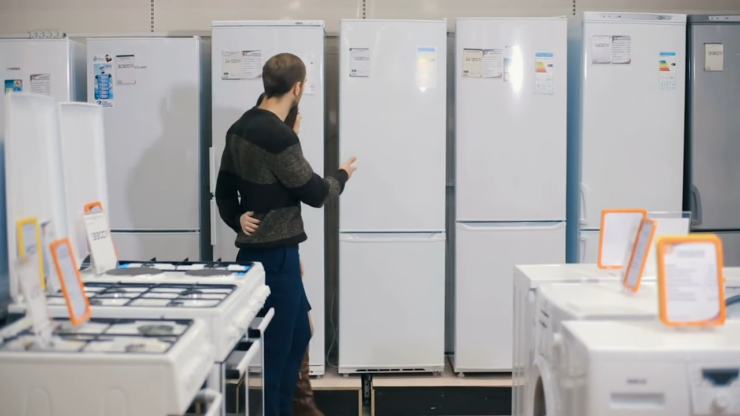
They are the common household appliance that uses electricity to help keep your food cold. But just how many amps does it use?
The average current range for a refrigerator is between 80 to 180 amps. This is determined by the refrigerator’s size, type, and features.
Standard
They generally use between 1.25 and 2 amperes, averaging 1.75 amperes, while larger refrigerators typically use between 3 and 5 amperes, averaging 4 amperes. Both single- and double-door units usually draw the same amount of power because they both have to run cooling fans, compressors, and energy-saving cycles.
The powerful compressors found in side-by-side models, however, drive up their electrical demand significantly–instead of consuming the average 2 to 4 amperes that most refrigerators do, side-by-sides can require up to 7 or 8! Generally speaking, it is important to keep in mind that the larger the refrigerator or freezer –or perhaps any appliance you are looking at–the more electricity it will consume.
Extra features like ice makers or temperature displays can add an additional strain on electricity and your total electric bill for the month may increase as a result. It is always best practice to double-check your appliance manual for the exact power requirements before purchasing a new one!
French Door Refrigerators
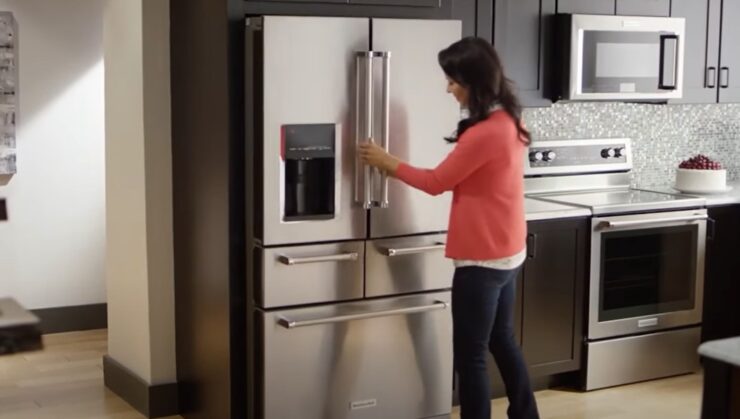
They are very popular with households because of their modern style and extra-large capacity. Depending on the size and type of compressor, French door models typically range from 18 to 24 cubic feet of interior storage space. This type is a bit more energy-efficient than a traditional side-by-side refrigerator, but it still has considerable energy requirements.
When it comes to power, they consume the same amount of electricity as an average top freezer cooler of the same size. With a capacity between 18 and 24 cubic feet, these refrigerators use an average of 545 kWh/year, which is slightly higher than their top freezer counterparts that hover around 510 kWh/year. This equates to about 4.5 Amps – roughly 8% more than side-by-side or top freezer models with similar capacities.
Side-by-Side
They are two-door units with the freezer located on one side and the refrigerator on the other. These models provide quick and easy access to both frozen and chilled items. Side-by-side models come in various sizes from extra large to very narrow, which are designed for tighter spaces.
Typical amps used for them are 8 Amps, but it really depends on the size and make/model of your refrigerator. To determine the exact number of amps used by your fridge, you’ll need to consult your user manual or contact the manufacturer directly.
Most of them have features such as adjustable shelves, multiple compartments in both the fresh food and freezer sections, and a more shallow depth than ordinary top freezer units offer. However, they require more electricity due to the extra utility of their features. On average, a standard 19 ft unit uses around 8 Amps while an extra large 24 ft consumption can use up to 11 Amps or even 12 Amps depending on its wattage rating which is usually between 650W – 850W.
Bottom Freezer
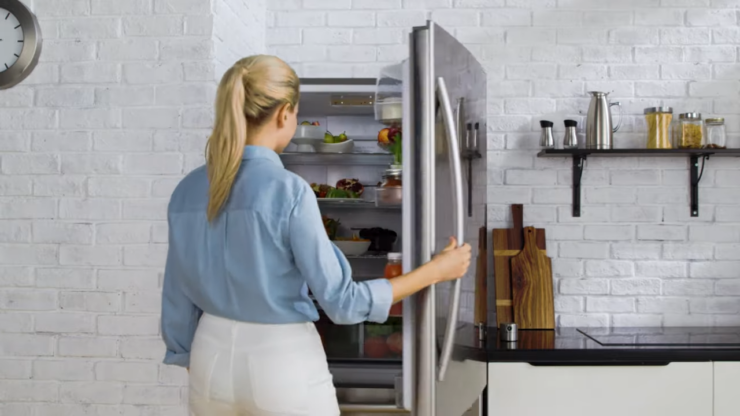
These tend to be more energy efficient than their top-freezer counterparts, with some models designed to exceed ENERGY STAR standards. On average, these models use between 4 and 7 amps, depending on the model and features you choose.
The noise level is typically lower due to their configuration. Many have exterior ice and water dispensers that require separate electrical outlets powering them at 1 amp each. The refrigerator lamps may use additional electricity if they are fluorescent or LED lights rather than incandescent bulbs.
It’s always important to read labels carefully before you buy so you can determine exactly how much electricity your chosen model will use each hour. Generally, however, they tend to be more energy efficient than top-freezer models when it comes to amps consumption.
How to Calculate the Amps
Calculating the number of amps that your cooler uses is important to save you money and keep it running efficiently. By knowing the total amps being used, you can determine if a certain voltage or circuit capacity is enough to support it. Knowing how many amps a cooler uses can also help you figure out how much power the appliance is using and how to lower it.
Calculate the Starting Amps

To calculate the starting amps for a refrigerator, you will need to use Ohm’s law. This law states that Voltage (V) is equal to Current (I) times Resistance (R). To determine the current (amps) being used by your refrigerator, you will need to measure its voltage and resistance. This can be done using an ohmmeter.
Once you have these measurements and put them into Ohm’s law equation, you will get a current rating in amperes or “amps.” The starting amps are important as they are necessary in order to determine how large a circuit breaker is needed and how much power is necessary for the appliance to function properly.
For example, if it runs on 220 volts with a resistance of 1 ohm, then the starting amps would be 220 Amps. If it runs on 120 volts with a resistance of 0.5 ohms, then the starting amps would be 240 Amps. By calculating the amount of current needed by your specific refrigerator model, you can properly determine how much power is necessary for its operation and set up appropriately sized circuit breakers accordingly.
Calculate the Running Amps
Calculating the running amperage for your cooler is an important factor in determining what size amp rating your circuit breaker and power cord must be. This calculation is simple enough for any homeowner to do, as it’s just a matter of multiplying the input wattage of the unit by the voltage of your house’s electrical system. The standard voltage in most homes in North America is 120 volts AC (alternating current).
To get started, locate an information label, usually somewhere on the back of the refrigerator. This label should include both the input wattage, usually expressed in watts (W), and an estimated yearly power consumption value, which should be expressed in kilowatt-hours (kWh) per year. Multiply this wattage value by 120 volts to get your refrigerator’s running amperage. For example, A cooler that has an input wattage of 200 watts would have a running amperage of 200 Watts x 120 Volts = 24 Amps.
FAQs
Can using a surge protector or power strip affect the amps used by my refrigerator?
Yes, using a surge protector or power strip can affect the amps used by your cooler, as it may not be designed to handle its high energy demands of it.
Does the size of a refrigerator affect the amps used?
Yes, the size can affect the amps used, as larger ones require more energy to operate.
Can an older refrigerator use more amps than a newer one?
Yes, they may use more amps than newer ones, as they may be less energy efficient and have outdated technology.
How can I reduce the amps used by my refrigerator?
You can reduce the amps by keeping it clean and well-maintained, avoiding overfilling it, and choosing a model with a high energy efficiency rating.
Can a refrigerator’s amps be affected by the location where it is placed?
Yes, the location where it is placed can affect its amps usage, as placing it in a warm or humid area can cause it to work harder and use more energy.
Can using the ice maker or water dispenser in a refrigerator affect its amps usage?
Yes, using the ice maker or water dispenser in it can affect its amps usage, as these features require additional energy to operate.
Can a power outage affect the amps used by a refrigerator?
No, a power outage does not affect the amps used by a refrigerator, as it requires electricity to operate.
How often should I replace my refrigerator?
You should consider replacing it if it is over 10 to 15 years old, if it requires frequent repairs, or if it is no longer meeting your needs.
How can I dispose of my old refrigerator?
You can dispose it of by contacting your local waste management facility or appliance recycling program, or by arranging for pickup through a retailer or manufacturer.
Conclusion
In conclusion, the number of amps can vary depending on factors such as the size and age of the appliance, as well as its energy efficiency rating. It is important to check the specifications for your specific refrigerator model to determine its amperage and ensure that it is operating efficiently. Additionally, regular maintenance and proper usage can help to minimize energy usage and prolong the lifespan of your refrigerator.

